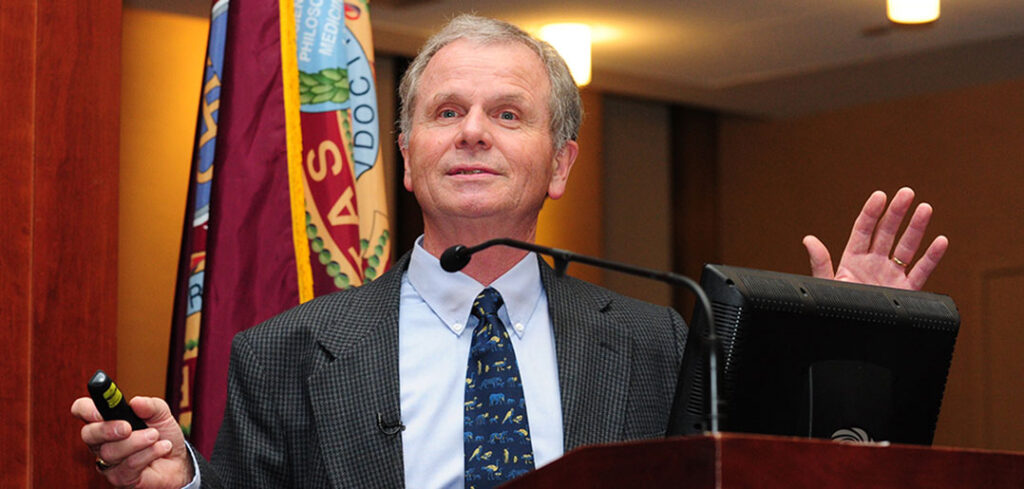On Nov. 6 Fordham welcomed home one of its most successful alumni in the field of science for a lecture about the value of curiosity, perseverance, and conviction.
Dan Molloy, Ph.D., FCRH ’69, GSAS ’71, research scientist at the University of Albany and founder of the New York State Museum’s Field Research Laboratory in Cambridge, N.Y., delivered “Needle in a Haystack Research Projects for Environmental Protection: Two Down and One To Go” at the Lincoln Center campus.
Molloy’s talk was part of the annual Fordham University Science Council lecture series.
Molloy spent nine years at the Rose Hill campus, attending Fordham Prep, Fordham College at Rose Hill, and the Graduate School of Arts and Sciences. He came to the University on a full scholarship after his father was killed while fighting a fire in the Bronx. Then-President Laurence J. McGinley, S.J., offered a free education to him and the children of the five other firefighters who died in the 1956 fire.
After earning a doctorate at the State University College of Environmental Science and Forestry in Syracuse, he devoted his career to developing environmentally safe biological control methods with the goal of reducing the use of harsh, polluting chemical pesticides.
The two “needles” he described looking for are bacteria—one that naturally kills black flies and another that kills zebra mussels. These animals are two pests whose proliferation has caused enormous economic damage to upstate tourism and power plants, respectively.
Swarms of black flies bite hikers and campers, said Molloy, while non-native zebra mussels clog water intake pipes at power plants. He has spent nearly a decade in both instances trying to isolate the bacteria that would kill each of them alone, with no “collateral” damage to other species.
“I’m a strange character. I may [even]be a masochist, because I love scientific challenges,” he said. “People say these challenges that I pick, they’re almost unsolvable.”
One of the bacteria, Bacillus thuringiensis israelensis, or BTI, was discovered by one of his colleagues and is now widely used in rivers and streams upstate against black flies. The beauty of the BTI bacteria is that it does not require creating an inorganic agent; organic material inside the bacteria’s cell kills the black fly larvae when ingested.
“Microbes also have a myriad of chemicals inside of them. If you’re persistent and you have adequate funding, you can put them together and get some great successes, like BTI,” he said.
In 1990, Molloy began his quest to pursue eradicating zebra mussels, with funding from the power industry.
“I looked at 700 bacterial species and I successfully identified 700 that didn’t do a damn thing against zebra mussels,” he recalled, admitting to feeling “pretty uncomfortable” about taking the industry’s money with no result.
“Fordham teaches you ethics. I went to the power companies, and I said ‘You gave me $700,000; I’ve spent $300,000. [Do] you want me to keep working on this?’”
Two months later, he found what he was looking for, and today, Zequanox, a commercial formulation of the bacterium, is being used by power plants to control invasive zebra mussels in intake drains.
For his next challenge, Molloy is looking for a way to manage zebra mussels throughout entire lakes and rivers, where the use of Zequanox or any other current control agent would be prohibitively expensive due to the large areas.
“Someone said to me, ‘You know Dan, you said you can’t control them in lakes. That sounds like a needle in a haystack problem.’ That’s all I needed to hear,” he said.
Molloy estimated it will take at least five years to identify the new biological organism and another five years to verify that it’s environmentally safe.
He credited Fordham for its emphasis on rigorous scholarship, public service, and adherence to ethical values.
“I’ve tried to take some of these characteristics and embody them in the conduct of my research over the years,” he said. “I don’t think I’d have the rich career that I’ve had without Fordham.”


